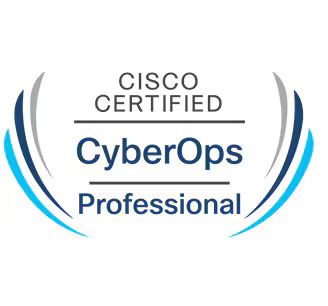
CyberOps Professional Certification
Show your expertise in preventing cyber attacks, responding to incidents, and securing the cloud. Advance your career with a Cisco CyberOps Professional certification.

Show your expertise in preventing cyber attacks, responding to incidents, and securing the cloud. Advance your career with a Cisco CyberOps Professional certification.
Show your expertise in preventing cyber attacks, responding to incidents, and securing the cloud. Advance your career with a Cisco CyberOps Professional certification.
Be the first line of defense with CyberOps Professional
Show your expertise in preventing cyber attacks, responding to incidents, and securing the cloud with a CyberOps Professional certification.

CyberOps Professional Certification
Security Fundamentals
Understand common cybersecurity incidents, prevention plans, compliance standards, and risk analysis. Compare security in different cloud platforms.
Security Techniques
Be able to secure computer systems, analyze security data, troubleshoot security systems, and prevent data loss. Demonstrate your knowledge of common attack tactics.
Security Processes
Analyze threats, investigate breaches, identify malware, understand attack events, and be able to recommend vulnerability mitigation techniques.
Security Automation
Use tools to automate tasks and employ scripts to improve efficiency. Understand data formats, web services, software deployment, and managing infrastructure using code.
How it works
No formal prerequisites
Learners often have three to five years of experience implementing enterprise network solutions.
Common learner profiles
Professional-level certifications expand on the foundations of associate-level certifications. They cover more advanced topics and allow candidates to hone in on a specific focus area of their choice. Many professional-level certification candidates are looking to prove they’re the best of the best in a specialized field.
CBRCOR – Cisco Certified CyberOps Professional
Network Security Engineer : Identify security vulnerabilities, and develop security systems and procedures to defend against all types of cybercrime. Cybersecurity Investigator : Gather evidence of cybercrime from computer systems to help apprehend internet, computer or cyber-based criminals. Incident Manager : Restore services and help return business operations to normal following an incident.
| Fees Structure : | 15500 INR / 185 USD |
| Total No of Class : | 69 Video Class |
| Class Duration : | 42:30 Working Hours |
| Download Feature : | Download Avalable |
| Technical Support : | Call / Whatsapp : +91 8680961847 |
| Working Hours : | Monday to Firday 9 AM to 6 PM |
| Payment Mode : | Credit Card / Debit Card / NetBanking / Wallet (Gpay/Phonepay/Paytm/WhatsApp Pay) |
| Fees Structure : | 22500 INR / 270 USD |
| Class Duration : | 60 Days |
| Class Recording : | Live Class Recording available |
| Class Time : | Monday to Firday 1.5 hours per day / Weekend 3 Hours per day |
| Technical Support : | Call / Whatsapp : +91 8680961847 |
| Working Hours : | Monday to Firday 9 AM to 6 PM |
| Payment Mode : | Credit Card / Debit Card / NetBanking / Wallet (Gpay/Phonepay/Paytm/WhatsApp Pay) |